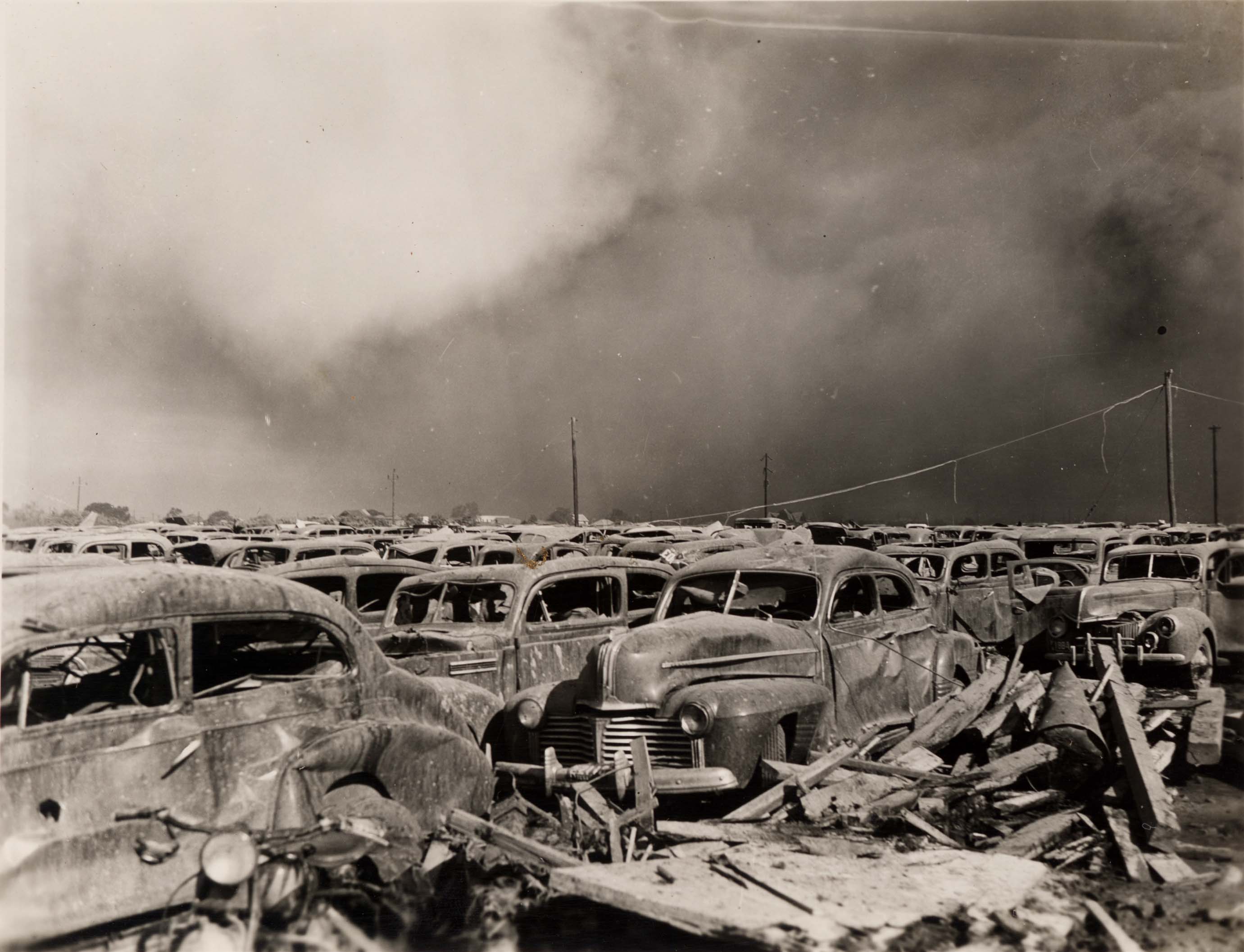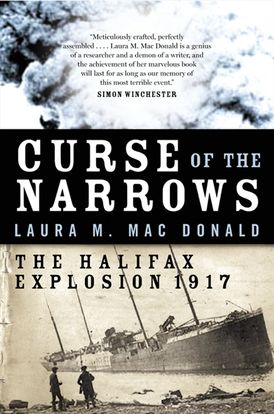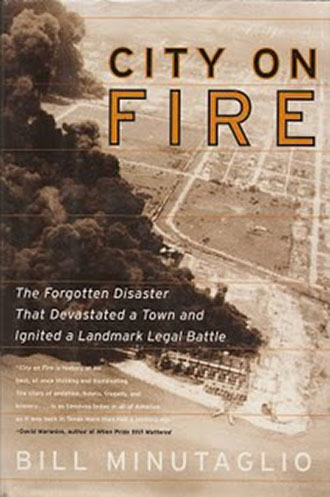General Discussion
Related: Editorials & Other Articles, Issue Forums, Alliance Forums, Region Forums72 Years Ago Today; The Texas City Disaster

The Texas City disaster was an industrial accident that occurred April 16, 1947 in the Port of Texas City, Texas. It was the deadliest industrial accident in U.S. history, and one of history's largest non-nuclear explosions. Originating with a mid-morning fire on board the French-registered vessel SS Grandcamp (docked in the port), her cargo of approximately 2,200 tons (approximately 2,100 metric tons) of ammonium nitrate detonated, initiating a subsequent chain-reaction of additional fires and explosions in other ships and nearby oil-storage facilities. It killed at least 581 people, including all but one member of the Texas City fire department. The disaster triggered the first ever class action lawsuit against the United States government, under the then-recently enacted Federal Tort Claims Act (FTCA), on behalf of 8,485 victims.
<snip>
Explosions
The ammonium nitrate, needed either as fertilizer or an explosive, was manufactured in Nebraska and Iowa and shipped to Texas City by rail before being loaded on the Grandcamp. It was manufactured in a patented process, mixed with clay, petrolatum, rosin and paraffin wax to avoid moisture caking. It was also packaged in paper sacks, then transported and stored at temperatures that increased its chemical activity. Longshoremen reported the bags were warm to the touch before loading.
On April 16, 1947, around 8:00 a.m. smoke was spotted in the cargo hold of the Grandcamp while she was still moored. Over the next hour, attempts to extinguish the fire or bring it under control failed as a red glow returned after each effort to douse the fire.
Shortly before 9:00 a.m., the captain ordered his men to steam the hold, a firefighting method where steam is piped in to extinguish fires, to preserve the cargo. This was unlikely to be effective, as ammonium nitrate produces its own oxygen, thus neutralizing the extinguishing properties of steam. The steam may have contributed to the fire by converting the ammonium nitrate to nitrous oxide, while augmenting the already intense heat in the ship's hold.
The fire attracted spectators along the shoreline, who believed they were at a safe distance. Eventually, the steam pressure inside the ship blew the hatches open, and yellow-orange smoke billowed out. This color is typical for nitrogen dioxide fumes. The unusual color of the smoke attracted more spectators. Spectators also noted that the water around the docked ship was boiling from the heat, and the splashing water touching the hull was being vaporized into steam. The cargo hold and deck began to bulge as the pressure of the steam increased inside.
At 9:12 a.m., the ammonium nitrate reached an explosive threshold from the combination of heat and pressure. The vessel then detonated, causing great destruction and damage throughout the port. The tremendous blast sent a 15-foot (4.5 m) wave that was detectable nearly 100 miles (160 km) off the Texas shoreline. The blast leveled nearly 1,000 buildings on land. The Grandcamp explosion destroyed the Monsanto Chemical Company plant and resulted in ignition of refineries and chemical tanks on the waterfront. Falling bales of burning twine from the ship's cargo added to the damage while the Grandcamp's anchor was hurled across the city. Two sightseeing airplanes flying nearby had their wings shorn off, forcing them out of the sky. 10 miles (16 km) away, half of the windows in Galveston were shattered. The explosion blew almost 6,350 short tons (5,760 metric tons) of the ship's steel into the air, some at supersonic speed. Official casualty estimates came to a total of 567, including all the crewmen who remained aboard the Grandcamp. All but one member of the 28-man Texas City volunteer fire department were killed in the initial explosion on the docks while fighting the shipboard fire. With fires raging throughout Texas City, first responders from other areas were initially unable to reach the site of the disaster.
The first explosion ignited ammonium nitrate in the nearby cargo ship High Flyer. The crews spent hours attempting to cut the High Flyer free from her anchor and other obstacles, without success. After smoke had been pouring from the hold for over five hours, and about 15 hours after the explosions aboard the Grandcamp, the High Flyer exploded, demolishing the nearby SS Wilson B. Keene, killing at least two more and increasing the damage to the port and other ships with more shrapnel and burning material. One of the propellers on the High Flyer was blown off and subsequently found nearly a mile inland. It is now part of a memorial park and sits near the anchor of the Grandcamp. The propeller is cracked in several places, and one blade has a large piece missing.
The cause of the initial fire on board the Grandcamp was never determined, but it may have been started by a cigarette discarded the previous day, meaning the ship's cargo had been smouldering throughout the night when it was discovered on the morning of the day of the explosion.
Scale of the disaster
The Texas City disaster is generally considered the worst industrial accident in American history. Witnesses compared the scene to the fairly recent images of the 1943 air raid on Bari and the much larger devastation at Nagasaki. Of the dead, 405 were identified and 63 have never been identified. These were placed in a memorial cemetery in the north part of Texas City near Moses Lake. An additional 113 people were classified as missing, for no identifiable parts were ever found. This figure includes firefighters who were aboard Grandcamp when she exploded. There is some speculation that there may have been hundreds more killed but uncounted, including visiting seamen, non-census laborers and their families, and an untold number of travelers. However, there were some survivors as close as 70 feet (21 m) from the dock. The victims' bodies quickly filled the local morgue, and several bodies were laid out in the local high school's gymnasium for identification by loved ones.

Parking lot 1?4 mile (0.40 km) away from the explosion
More than 5,000 people were injured, with 1,784 admitted to 21 area hospitals. More than 500 homes were destroyed and hundreds damaged, leaving 2,000 homeless. The seaport was destroyed, and many businesses were flattened or burned. Over 1,100 vehicles were damaged and 362 freight cars were obliterated—the property damage was estimated at $100 million[7] (equivalent to $1,100,000,000 in 2018).
A 2-short-ton (1.8-metric-ton) anchor of Grandcamp was hurled 1.62 miles (2.61 km) and found in a 10-foot (3 m) crater. It now rests in a memorial park. The other main 5-short-ton (4.5-metric-ton) anchor was hurled 1?2 mile (800 m) to the entrance of the Texas City Dike, and rests on a "Texas-shaped" memorial at the entrance. Burning wreckage ignited everything within miles, including dozens of oil storage tanks and chemical tanks. The nearby city of Galveston, Texas, was covered with an oily fog which left deposits over every exposed outdoor surface.
Firefighting casualties
Some of the deaths and damage in Texas City were due to the destruction and subsequent burning of several chemical plants (including Monsanto and Union Carbide), oil storage, and other facilities near the explosions. 27 of the 28 members of Texas City's volunteer fire department and 3 of 4 members of the Texas City Heights Volunteer Fire Department who were on the docks near the burning ship were killed. One firefighter, Fred Dowdy, who had not responded to the initial call, coordinated other firefighters arriving from communities up to 60 miles (100 km) away. Alvin Fussell, sole survivor of the Heights Volunteer fire fighters, was driving to work in Alvin when he heard of the fire on the radio. Eventually 200 firefighters arrived, from as far away as Los Angeles. Fires resulting from the cataclysmic events were still burning a week after the disaster, and the process of body recovery took nearly a month. All four fire engines of Texas City were twisted and burned hulks.
</snip>
Sherman A1
(38,958 posts)A very interesting story. I had read about this years ago, but nice to refresh our memory.
malaise
(269,196 posts)albeit on a smaller scale?
ProfessorGAC
(65,227 posts)About 6 years ago. Same compound, ammonium nitrate.
Mixed with fuel oil (called ANFO) it's the same high pressure, low speed explosive used by Nichols and McVeigh in OKC.
[link:https://en.m.wikipedia.org/wiki/West_Fertilizer_Company_explosion|
kag
(4,079 posts)My father grew up there. (We used to go visit my grandparents in West for Christmas and summers.) My dad was living back in West when the explosion happened. When I went to visit him the following summer he took us on a tour of the site.
It was huge, but nothing like Texas City. I was born in '63, and I remember hearing about Texas City growing up, twenty years later. I might, in fact, have had relatives among the dead or injured as we had a lot of family working as roughnecks and engineers for oil companies.
I read a book called "The Town that Died" about the Halifax disaster. It was fascinating, and the explosion was, I believe, even bigger than the Texas City explosion.
malaise
(269,196 posts)FailureToCommunicate
(14,025 posts)Last edited Tue Apr 16, 2019, 08:44 AM - Edit history (1)
too close to civilian population centers. AND people flocking down to watch what they thought was just a typical fire. Horrific.
https://www.washingtonpost.com/news/retropolis/wp/2017/12/06/two-ships-collided-in-halifax-harbor-one-of-them-was-a-3000-ton-floating-bomb/?utm_term=.587cf2d1d712
kag
(4,079 posts)Pretty much destroyed the entire city. I referred in a comment above to a book I read called "The Town that Died". An unfortunate title, because it didn't just "die", at was blown away by a single ship overloaded with very volatile explosives.
mahatmakanejeeves
(57,647 posts)Previously at DU:
The Halifax Explosion, December 6, 1917, One Hundred Years Ago Today
The Halifax Explosion was a maritime disaster in Halifax, Nova Scotia, Canada, on the morning of 6 December 1917. SS Mont-Blanc, a French cargo ship laden with high explosives, collided with the Norwegian vessel SS Imo in the Narrows, a strait connecting the upper Halifax Harbour to Bedford Basin. A fire on board the French ship ignited her cargo, causing a large explosion that devastated the Richmond district of Halifax. Approximately 2,000 people were killed by the blast, debris, fires or collapsed buildings, and an estimated 9,000 others were injured. The blast was the largest man-made explosion before the development of nuclear weapons, releasing the equivalent energy of roughly 2.9 kilotons of TNT (12,000 GJ).
Mont-Blanc was under orders from the French government to carry her cargo of high explosives from New York via Halifax to Bordeaux, France. At roughly 8:45 am, she collided at low speed, approximately one knot (1.2 mph or 1.9 km/h), with the unladen Imo, chartered by the Commission for Relief in Belgium to pick up a cargo of relief supplies in New York. The resulting fire on board the French ship quickly grew out of control. Approximately 20 minutes later at 9:04:35 am, the Mont-Blanc exploded.
....
Explosion
At 9:04:35 am (almost 20 minutes after the collision), the out-of-control fire on board Mont-Blanc set off her highly explosive cargo. The ship was completely blown apart and a powerful blast wave radiated away from the explosion at more than 1,000 metres (3,300 ft) per second. Temperatures of 5,000 °C (9,000 °F) and pressures of thousands of atmospheres accompanied the moment of detonation at the centre of the explosion. White-hot shards of iron fell down upon Halifax and Dartmouth. Mont-Blanc's forward 90 mm gun, its barrel melted away, landed approximately 5.6 kilometres (3.5 mi) north of the explosion site near Albro Lake in Dartmouth, while the shank of her anchor, weighing half a ton, landed 3.2 kilometres (2.0 mi) south at Armdale.
A cloud of white smoke rose to over 3,600 metres (11,800 ft). The shock wave from the blast travelled through the earth at nearly 23 times the speed of sound and was felt as far away as Cape Breton (207 kilometres or 129 miles) and Prince Edward Island (180 kilometres or 110 miles). An area of over 160 hectares (400 acres) was completely destroyed by the explosion, while the harbour floor was momentarily exposed by the volume of water that vaporized. A tsunami was formed by water surging in to fill the void; it rose as high as 18 metres (60 ft) above the high-water mark on the Halifax side of the harbour. Imo was carried onto the shore at Dartmouth by the tsunami. The blast killed all but one on the whaler, everyone on the pinnace and 21 of the 26 men on Stella Maris; she ended up on the Dartmouth shore, severely damaged. The captain's son, First Mate Walter Brannen, who had been thrown into the hold by the blast, survived, as did four others. All but one of the Mont-Blanc crew members survived.
Over 1,600 people were killed instantly and 9,000 were injured, more than 300 of whom later died. Every building within a 2.6-kilometre (1.6 mi) radius, over 12,000 in total, was destroyed or badly damaged. Hundreds of people who had been watching the fire from their homes were blinded when the blast wave shattered the windows in front of them. Stoves and lamps overturned by the force of the blast sparked fires throughout Halifax, particularly in the North End, where entire city blocks were caught up in the inferno, trapping residents inside their houses. Firefighter Billy Wells, who was thrown away from the explosion and had his clothes torn from his body, described the devastation survivors faced: "The sight was awful, with people hanging out of windows dead. Some with their heads missing, and some thrown onto the overhead telegraph wires." He was the only member of the eight-man crew of the fire engine Patricia to survive.
....
The death toll could have been worse had it not been for the self-sacrifice of an Intercolonial Railway dispatcher, Patrick Vincent (Vince) Coleman, operating at the railyard about 750 feet (230 m) from Pier 6, where the explosion occurred. He and his co-worker, William Lovett, learned of the dangerous cargo aboard the burning Mont-Blanc from a sailor and began to flee. Coleman remembered, however, that an incoming passenger train from Saint John, New Brunswick, was due to arrive at the railyard within minutes. He returned to his post alone and continued to send out urgent telegraph messages to stop the train. Several variations of the message have been reported, among them this from the Maritime Museum of the Atlantic: "Hold up the train. Ammunition ship afire in harbor making for Pier 6 and will explode. Guess this will be my last message. Good-bye boys." Coleman's message was responsible for bringing all incoming trains around Halifax to a halt. It was heard by other stations all along the Intercolonial Railway, helping railway officials to respond immediately. Passenger Train No. 10, the overnight train from Saint John, is believed to have heeded the warning and stopped a safe distance from the blast at Rockingham, saving the lives of about 300 railway passengers. Coleman was killed at his post as the explosion ripped through the city. He was honoured with a Heritage Minute in the 1990s and inducted into the Canadian Railway Hall of Fame in 2004.
....
Legacy
....
In 1918, Halifax sent a Christmas tree to the City of Boston in thanks and remembrance for the help that the Boston Red Cross and the Massachusetts Public Safety Committee provided immediately after the disaster. That gift was revived in 1971 by the Lunenburg County Christmas Tree Producers Association, which began an annual donation of a large tree to promote Christmas tree exports as well as acknowledge Boston's support after the explosion. The gift was later taken over by the Nova Scotia Government to continue the goodwill gesture as well as to promote trade and tourism. The tree is Boston's official Christmas tree and is lit on Boston Common throughout the holiday season. In deference to its symbolic importance for both cities, the Nova Scotia Department of Natural Resources has specific guidelines for selecting the tree.
eppur_se_muova
(36,299 posts)
If anything, this book is even more harrowing than "City on Fire".
eppur_se_muova
(36,299 posts)Apparently, people were unaware back then that ammonium nitrate was an explosive, and the bags were not marked as such. They were shipped in boxcars carrying a certificate *inside* verifying that the contents were to be handled as munitions, but no markings outside the cars.
Most of the chemical plants were built outside city limits to avoid taxes, and Texas City was so short of funds they sold their only fireboat. The neighborhood nearest the docks was occupied by poor Hispanic families who had few if any legal records, which is largely responsible for the huge uncertainty in the casualty figures -- many of the dockworkers and their families simply vanished in the explosion, and their homes were obliterated.
Texas City was built and organized for the benefit of big corporations -- i.e., a Republican paradise for top management, and a hellhole for anyone not holding company stock. The long ordeal of those attempting to hold the responsible parties accountable does not make American justice look particularly good.
http://www.billminutaglio.com/cityonfire.html

FrankBooth
(1,608 posts)He was an engineer and was at work as usual, but had to run back home to his house in La Marque as he'd forgotten something that morning. He was on his way back home and was just far enough away from the blast that he was only injured, not incinerated.
My aunt has often talked about the effect the event had on the family and community -- scary stuff.
TexasBushwhacker
(20,220 posts)A 2 ton hunk of metal hurled over 1.5 miles.